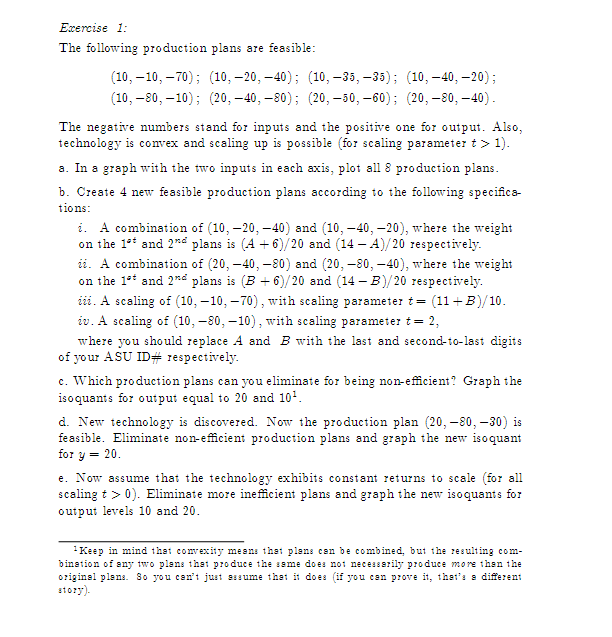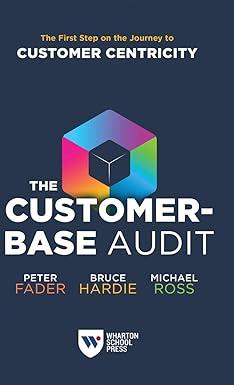
Exercise 1: The following production plans are feasible: (10,10,70);(10,20,40);(10,35,35);(10,40,20); (10,80,10);(20,40,80);(20,50,60);(20,80,40). The negative numbers stand for inputs and the positive one for output. Also, technology is convex and scaling up is possible (for scaling parameter t>1 ). a. In a graph with the two inputs in each axis, plot all 8 production plans. b. Create 4 new feasible production plans according to the following specifications: i. A combination of (10,20,40) and (10,40,20), where the weight on the 1ot and 2nd plans is (A+6)/20 and (14A)/20 respectively. ii. A combination of (20,40,80) and (20,80,40), where the weight on the 1t and 2nd plans is (B+6)/20 and (14B)/20 respectively. iii. A scaling of (10,10,70), with scaling parameter t=(11+B)/10. iv. A scaling of (10,80,10), with scaling parameter t=2, where you should replace A and B with the last and second-to-last digits of your ASU ID # respectively. c. Which production plans can you eliminate for being non-efficient? Graph the isoquants for output equal to 20 and 101. d. New technology is discovered. Now the production plan (20,80,30) is feasible. Eliminate non-efficient production plans and graph the new isoquant for y=20. e. Now assume that the technology exhibits constant returns to scale (for all scaling t>0 ). Eliminate more inefficient plans and graph the new isoquants for output levels 10 and 20 . I Keep in mind that convexity meang that plans can be combined, but the sesuling combination of any two plans that produce the same does not necessrily produce more than the originel plans. 80 you can't just asaume that it does (if you can prove it, that's a different sto:y]. Exercise 1: The following production plans are feasible: (10,10,70);(10,20,40);(10,35,35);(10,40,20); (10,80,10);(20,40,80);(20,50,60);(20,80,40). The negative numbers stand for inputs and the positive one for output. Also, technology is convex and scaling up is possible (for scaling parameter t>1 ). a. In a graph with the two inputs in each axis, plot all 8 production plans. b. Create 4 new feasible production plans according to the following specifications: i. A combination of (10,20,40) and (10,40,20), where the weight on the 1ot and 2nd plans is (A+6)/20 and (14A)/20 respectively. ii. A combination of (20,40,80) and (20,80,40), where the weight on the 1t and 2nd plans is (B+6)/20 and (14B)/20 respectively. iii. A scaling of (10,10,70), with scaling parameter t=(11+B)/10. iv. A scaling of (10,80,10), with scaling parameter t=2, where you should replace A and B with the last and second-to-last digits of your ASU ID # respectively. c. Which production plans can you eliminate for being non-efficient? Graph the isoquants for output equal to 20 and 101. d. New technology is discovered. Now the production plan (20,80,30) is feasible. Eliminate non-efficient production plans and graph the new isoquant for y=20. e. Now assume that the technology exhibits constant returns to scale (for all scaling t>0 ). Eliminate more inefficient plans and graph the new isoquants for output levels 10 and 20 . I Keep in mind that convexity meang that plans can be combined, but the sesuling combination of any two plans that produce the same does not necessrily produce more than the originel plans. 80 you can't just asaume that it does (if you can prove it, that's a different sto:y]







